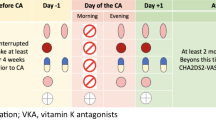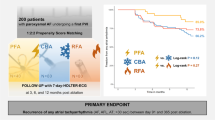Abstract
Objective
To evaluate whether the effect of radiofrequency ablation can be improved by using sacubitril/valsartan (S/V) to control blood pressure in hypertensive patients with persistent atrial fibrillation.
Methods
A total of 63 and 67 hypertension patients with persistent atrial fibrillation were enrolled in an S/V group and ACEI/ARB group, respectively. All patients underwent radiofrequency catheter ablation (RFCA). The blood pressure of the two groups was controlled within the range of 100–140 mmHg (high pressure) and 60–90 mmHg (low pressure). The clinical outcomes of the two groups were observed after 12 months of follow-up.
Results
No significant differences in blood pressure were observed between the S/V and ACEI/ARB groups. In addition, the recurrence rate of atrial fibrillation between the two groups was not different. The left atrial diameter was an independent predictor of recurrence (HR = 1.063, P = 0.008). However, in the heart failure subgroup, the recurrence rate of S/V was significantly lower than that of the ACEI/ARB group (P = 0.005), and Cox regression analysis showed that the recurrence risk of atrial fibrillation of the S/V group was 0.302 lower than that of the ACEI/ARB group. NT-proBNP, LVEF, and LAD were significantly improved in hypertension patients with heart failure when comparing cases before and at the end of follow-up.
Conclusions
S/V is better than ACEI/ARB in reducing the recurrence of persistent atrial fibrillation in patients with hypertension and heart failure after RFCA.



Similar content being viewed by others
Data Availability
Data are accessible or available upon request.
References
Ruilope LM, Dukat A, Böhm M, Lacourcière Y, Gong J, Lefkowitz MP. Blood-pressure reduction with LCZ696, a novel dual-acting inhibitor of the angiotensin II receptor and neprilysin: a randomised, double-blind, placebo-controlled, active comparator study. Lancet. 2010;375(9722):1255–66.
Jackson AM, Jhund PS, Anand IS, Düngen HD, Lam CSP, Lefkowitz MP, et al. Sacubitril-valsartan as a treatment for apparent resistant hypertension in patients with heart failure and preserved ejection fraction. Eur Heart J. 2021;42(36):3741–52.
January CT, Wann LS, Calkins H, Chen LY, Cigarroa JE, Cleveland JC Jr, et al. 2019 AHA/ACC/HRS focused update of the 2014 AHA/ACC/HRS guideline for the management of patients with atrial fibrillation: a report of the American College of Cardiology/American Heart Association Task Force on Clinical Practice Guidelines and the Heart Rhythm Society in Collaboration With the Society of Thoracic Surgeons. Circulation. 2019;140(2):e125–51.
Lévy S, Steinbeck G, Santini L, Nabauer M, Maceda DP, Kantharia BK, et al. Management of atrial fibrillation: two decades of progress – a scientific statement from the European Cardiac Arrhythmia Society. J Interv Card Electrophysiol. 2022;65(1):287–326.
Di Biase L, Mohanty P, Mohanty S, Santangeli P, Trivedi C, Lakkireddy D, Reddy M, Jais P, Themistoclakis S, Dello Russo A, et al. Ablation versus amiodarone for treatment of persistent atrial fibrillation in patients with congestive heart failure and an implanted device: results from the AATAC multicenter randomized trial. Circulation. 2016;133:1637–44.
Marrouche NF, Brachmann J, Andresen D, Siebels J, Boersma L, Jordaens L, et al. Catheter ablation for atrial fibrillation with heart failure. N Engl J Med. 2018;378(5):417–27.
Sayed A, Awad AK, Abdelfattah OM, Elsayed M, Herzallah K, Marine JE, et al. The impact of catheter ablation in patient’s heart failure and atrial fibrillation: a meta-analysis of randomized clinical trials. J Interv Card Electrophysiol. 2023;66(6):1487–97.
Kuck KH, Merkely B, Zahn R, Arentz T, Seidl K, Schluter M, et al. Catheter ablation versus best medical therapy in patients with persistent atrial fibrillation and congestive heart failure: the randomized AMICA trial. Circ Arrhythm Electrophysiol. 2019;12:e007731.
Chen Q, Chen Y, Qin F, Du H, Gan C, Zhou B, et al. Effect of sacubitril-valsartan on restoration and maintenance of sinus rhythm in patients with persistent atrial fibrillation. Front Cardiovasc Med. 2022;9:870203.
Wang Q, Zhuo C, Xia Q, Jiang J, Wu B, Zhou D, et al. Sacubitril/valsartan can reduce atrial fibrillation recurrence after catheter ablation in patients with persistent atrial fibrillation. Cardiovasc Drugs Ther. 2023;37(3):549–60.
Liu J. Highlights of the 2018 Chinese hypertension guidelines. Clin Hypertens. 2020;26:8.
Dong JZ, Sang CH, Yu RH, Long DY, Tang RB, Jiang CX, et al. Prospective randomized comparison between a fixed ‘2C3L’ approach vs. stepwise approach for catheter ablation of persistent atrial fibrillation. Europace. 2015;17(12):1798–806.
Yancy CW, Jessup M, Bozkurt B, Butler J, Casey DE Jr, Colvin MM, et al. 2017 ACC/AHA/HFSA focused update of the 2013 ACCF/AHA guideline for the management of heart failure: a report of the American College of Cardiology/American Heart Association Task Force on Clinical Practice Guidelines and the Heart Failure Society of America. Circulation. 2017;136(6):e137–61.
Kario K, Sun N, Chiang FT, Supasyndh O, Baek SH, Inubushi-Molessa A, et al. Efficacy and safety of LCZ696, a first-in-class angiotensin receptor neprilysin inhibitor, in Asian patients with hypertension: a randomized, double-blind, placebo-controlled study. Hypertension. 2014;63(4):698–705.
Madrid AH, Bueno MG, Rebollo JM, Marín I, Peña G, Bernal E, et al. Use of irbesartan to maintain sinus rhythm in patients with long-lasting persistent atrial fibrillation: a prospective and randomized study. Circulation. 2002;106(3):331–6.
Ueng KC, Tsai TP, Yu WC, Tsai CF, Lin MC, Chan KC, et al. Use of enalapril to facilitate sinus rhythm maintenance after external cardioversion of long-standing persistent atrial fibrillation. Results of a prospective and controlled study. Eur Heart J. 2003;24(23):2090–8.
Liu X, Liu H, Wang L, Zhang L, Xu Q. Role of sacubitril-valsartan in the prevention of atrial fibrillation occurrence in patients with heart failure: a systematic review and meta-analysis of randomized controlled trials. PLoS One. 2022;17(1):e0263131.
Li SN, Zhang JR, Zhou L, Xi H, Li CY, Zhao L. Sacubitril/valsartan decreases atrial fibrillation susceptibility by inhibiting angiotensin II-induced atrial fibrosis through p-Smad2/3, p-JNK, and p-p38 signaling pathways. J Cardiovasc Transl Res. 2022;15(1):131–42.
Li LY, Lou Q, Liu GZ, Lv JC, Yun FX, Li TK, et al. Sacubitril/valsartan attenuates atrial electrical and structural remodelling in a rabbit model of atrial fibrillation. Eur J Pharmacol. 2020;881:173120.
Suo Y, Yuan M, Li H, Zhang Y, Li Y, Fu H, et al. Sacubitril/valsartan improves left atrial and left atrial appendage function in patients with atrial fibrillation and in pressure overload-induced mice. Front Pharmacol. 2019;10:1285.
Yang L, Zhang M, Hao Z, Wang N, Zhang M. Sacubitril/valsartan attenuates atrial structural remodelling in atrial fibrillation patients. ESC Heart Fail. 2022;9(4):2428–34.
Schmieder RE, Wagner F, Mayr M, Delles C, Ott C, Keicher C, et al. The effect of sacubitril/valsartan compared to olmesartan on cardiovascular remodelling in subjects with essential hypertension: the results of a randomized, double-blind, active-controlled study. Eur Heart J. 2017;38(44):3308–17.
Desai AS, Solomon SD, Shah AM, Claggett BL, Fang JC, Izzo J, et al. Effect of sacubitril-valsartan vs enalapril on aortic stiffness in patients with heart failure and reduced ejection fraction: a randomized clinical trial. JAMA. 2019;322(11):1077–84.
De Vecchis R, Paccone A, Di Maio M. Favorable effects of sacubitril/valsartan on the peak atrial longitudinal strain in patients with chronic heart failure and a history of one or more episodes of atrial fibrillation: a retrospective cohort study. J Clin Med Res. 2020;12(2):100–7.
Russo V, Bottino R, Rago A, Papa AA, Liccardo B, Proietti R, et al. The effect of sacubitril/valsartan on device detected arrhythmias and electrical parameters among dilated cardiomyopathy patients with reduced ejection fraction and implantable cardioverter defibrillator. J Clin Med. 2020;9(4):1111.
de Diego C, González-Torres L, Núñez JM, CenturiónInda R, Martin-Langerwerf DA, Sangio AD, et al. Effects of angiotensin-neprilysin inhibition compared to angiotensin inhibition on ventricular arrhythmias in reduced ejection fraction patients under continuous remote monitoring of implantable defibrillator devices. Heart Rhythm. 2018;15(3):395–402.
Pan J, Xu C, Xu B, Lou Y, Wang S, Xing Y. Relationship between the time point of left atrial size change and the outcomes of radiofrequency catheter ablation. J Interv Card Electrophysiol. 2022;64(3):669–75.
Magnani S, Muser D, Chik W, Santangeli P. Adjunct ablation strategies for persistent atrial fibrillation-beyond pulmonary vein isolation. J Thorac Dis. 2015;7(2):178–84.
Kreidieh O, Varley AL, Romero J, Singh D, Silverstein J, Thosani A, et al. Practice patterns of operators participating in the Real-World Experience of Catheter Ablation for Treatment of Symptomatic Paroxysmal and Persistent Atrial Fibrillation (REAL-AF) Registry. J Interv Card Electrophysiol. 2022;65(2):429–40.
Dixit S, Marchlinski FE, Lin D, Callans DJ, Bala R, Riley MP, et al. Randomized ablation strategies for the treatment of persistent atrial fibrillation: RASTA study. Circ Arrhythm Electrophysiol. 2012;5(2):287–94.
Wu S, Li H, Yi S, Yao J, Chen X. Comparing the efficacy of catheter ablation strategies for persistent atrial fibrillation: a Bayesian analysis of randomized controlled trials. J Interv Card Electrophysiol. 2023;66(3):757–70.
Weng W, Birnie DH, Ramirez FD, Van Stiphout C, Golian M, Nery PB, et al. Outcomes of a comprehensive strategy during repeat atrial fibrillation ablation. J Interv Card Electrophysiol. 2022;65(2):391–9.
Yamashita S, Tokuda M, Mahida S, Sato H, Ikewaki H, Oseto H, et al. Very long term outcome after linear versus electrogram guided ablation for persistent atrial fibrillation. Sci Rep. 2021;11(1):23591.
Funding
This work was supported by the Joint Construction Project of Henan Medical Science and Technology (LHGJ20210091), Science and Technology Project of Henan Province (222102310065), and Cuttingedge and Basic Research Project of Henan Province (122300410136).
Author information
Authors and Affiliations
Contributions
Conception and design of the study: Xiaobiao Zang, Zhihan Zhao, Yonghui Zhao, and Rongfeng Zhang. Data collection: Xiaobiao Zang, Zhihan Zhao, Ke Chen, Weifeng Song, Jifang Ma, You Zhou, and Erpeng Liang. Data analysis: Xiaobiao Zang, Haixia Fu, and Xianqing Wang. Manuscript writing: Xiaobiao Zang and Zhihan Zhao. Critical revision: Yonghui Zhao and Rongfeng Zhang. All authors have read and approved the final manuscript.
Corresponding authors
Ethics declarations
Ethics Approval and Consent to Participate
This study was approved by the Ethics Committee of Henan Provincial People’s Hospital. The protocol and consent form were approved by the institutional review board of the Henan Provincial People’s Hospital. All patients provided written informed consent for participation before study entry.
Consent for Publication
All authors reviewed the manuscript and approved its submission.
Conflict of Interest
The authors declare no competing interests.
Additional information
Publisher's Note
Springer Nature remains neutral with regard to jurisdictional claims in published maps and institutional affiliations.
Rights and permissions
Springer Nature or its licensor (e.g. a society or other partner) holds exclusive rights to this article under a publishing agreement with the author(s) or other rightsholder(s); author self-archiving of the accepted manuscript version of this article is solely governed by the terms of such publishing agreement and applicable law.
About this article
Cite this article
Zang, X., Zhao, Z., Chen, K. et al. Evaluation of the Efficacy of Sacubitril/Valsartan on Radiofrequency Ablation in Patients with Hypertension and Persistent Atrial Fibrillation. Cardiovasc Drugs Ther (2023). https://doi.org/10.1007/s10557-023-07493-6
Accepted:
Published:
DOI: https://doi.org/10.1007/s10557-023-07493-6




